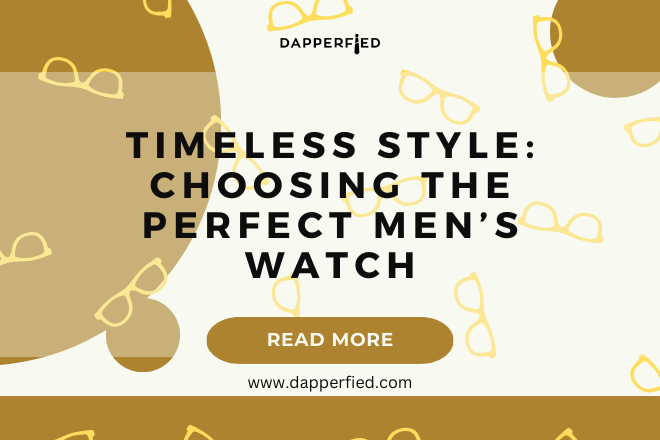
Men's Style
Essential Tips for Buying a Men’s Watch
When it comes to choosing a watch, it’s important to consider your personal style. Are you someone who prefers a classic and timeless look, or do you lean towards more modern and trendy designs? Your style will play a significant role in determining the type of watch that will best suit you. If you have a more traditional style, you may want to consider a watch with a leather strap and a simple, understated dial. On the other hand, if you have a more contemporary style, you might be drawn to watches with metal bracelets and bold, eye-catching designs. It’s also important to consider the occasions for which you’ll be wearing the watch. If you need a watch for everyday wear, you may want to opt for something versatile that can easily transition from day to night. However, if you’re in the market for a special occasion watch, you may want to invest in something more luxurious and elegant.
When considering your style, it’s also important to think about the size and shape of the watch. If you have a smaller wrist, you may want to opt for a watch with a smaller case size to ensure that it doesn’t overpower your wrist. Conversely, if you have a larger wrist, you may want to consider a watch with a larger case size to make a statement. Additionally, the shape of the watch can also play a role in determining whether it complements your style. Round watches are classic and versatile, while square or rectangular watches can add a modern and edgy touch to your look. Ultimately, choosing a watch that aligns with your personal style will ensure that you feel confident and comfortable wearing it.
Key Takeaways
- Your personal style and preferences should guide your watch selection
- Set a budget before starting your search to narrow down options
- Research various brands and models to find the best fit for your needs
- Consider the features you want in a watch, such as water resistance or a chronograph
- Pay attention to the materials used in the watch’s construction for durability and style
- Check the warranty and after-sales service offered by the brand
- Always try the watch on before making a purchase to ensure it fits and feels comfortable
Determine Your Budget
Before embarking on your search for the perfect watch, it’s essential to determine your budget. Watches come in a wide range of price points, from affordable options to luxury timepieces that come with a hefty price tag. By establishing your budget upfront, you can narrow down your options and focus on finding a watch that not only meets your style preferences but also falls within your financial means. When setting your budget, it’s important to consider the long-term value of the watch. While it may be tempting to opt for a cheaper option, investing in a higher quality timepiece may prove to be more cost-effective in the long run as it is likely to last longer and retain its value.
When determining your budget, it’s also important to consider any additional costs that may come with owning a watch. For example, some watches may require regular maintenance or servicing, which can add to the overall cost of ownership. Additionally, if you’re considering purchasing a luxury watch, it’s important to factor in the potential costs of insurance and repairs. By carefully considering your budget and factoring in any potential additional costs, you can ensure that you make an informed decision when it comes to purchasing a watch.
Research Different Brands and Models
Once you have an idea of your style preferences and budget, it’s time to start researching different brands and models of watches. There are countless watch brands on the market, each with its own unique history, design aesthetic, and reputation for quality. It’s important to take the time to familiarize yourself with the various brands and their offerings to ensure that you make an informed decision. Consider factors such as the brand’s heritage and reputation, as well as the materials and craftsmanship that go into their watches.
When researching different brands and models, it’s also important to consider the specific features and functions that are important to you. For example, if you lead an active lifestyle, you may want to consider a watch with features such as water resistance and a durable case. On the other hand, if you’re looking for a watch that can seamlessly transition from day to night, you may want to prioritize features such as a date function or a versatile strap option. By carefully researching different brands and models, you can ensure that you find a watch that not only aligns with your style preferences but also meets your practical needs.
In addition to researching different brands and models online, consider visiting local retailers or authorized dealers to see the watches in person. This will give you the opportunity to try on different styles and get a feel for the quality and craftsmanship of each watch. Ultimately, taking the time to thoroughly research different brands and models will ensure that you make an informed decision when it comes to purchasing a watch.
Consider the Watch’s Features
“`html
| Feature | Description |
|---|---|
| Water Resistance | The watch is water resistant up to 50 meters. |
| Battery Life | The battery can last up to 48 hours with normal usage. |
| Display | The watch has a high-resolution OLED display. |
| Connectivity | It can connect to both iOS and Android devices via Bluetooth. |
“`
When choosing a watch, it’s important to consider the specific features that are important to you. Watches come with a wide range of functions and complications, so it’s essential to prioritize the features that align with your lifestyle and practical needs. For example, if you travel frequently or work across different time zones, you may want to consider a watch with multiple time zone functionality or a GMT complication. On the other hand, if you lead an active lifestyle, features such as water resistance and a durable case may be top priorities for you.
In addition to practical features, it’s also important to consider any additional functions or complications that appeal to you. For example, some watches come with chronograph functions for timing events, while others may have moon phase displays or day-date complications. It’s important to carefully consider which features are important to you and prioritize them when selecting a watch. By doing so, you can ensure that the watch you choose not only meets your practical needs but also aligns with your personal preferences.
When considering the features of a watch, it’s also important to think about how they will impact the overall design and aesthetics of the timepiece. Some complications may add visual interest and complexity to the dial, while others may be more understated and minimalist in their design. Ultimately, carefully considering the features of a watch will ensure that you find a timepiece that not only meets your practical needs but also aligns with your personal style.
Pay Attention to the Materials
The materials used in a watch play a significant role in determining its overall quality, durability, and aesthetic appeal. When choosing a watch, it’s important to pay attention to the materials used in its construction to ensure that it meets your standards for craftsmanship and longevity. One of the most critical components of a watch is its case material. Watches are commonly made from materials such as stainless steel, titanium, gold, or ceramic. Each material has its own unique properties in terms of durability, weight, and resistance to scratches and corrosion.
In addition to the case material, it’s essential to consider the materials used for the dial, hands, and markers of the watch. High-quality watches often feature dials made from materials such as enamel or mother-of-pearl, which add depth and visual interest to the timepiece. The hands and markers of the watch are typically made from materials such as gold or luminescent coatings for enhanced visibility in low-light conditions.
When it comes to straps or bracelets, there are numerous options available, including leather, metal, rubber, or fabric. Each material offers its own unique look and feel, so it’s important to consider which option best complements your personal style and practical needs. By paying attention to the materials used in a watch, you can ensure that you select a timepiece that not only meets your standards for quality and craftsmanship but also aligns with your style preferences.
Check the Warranty and After-Sales Service

Before making a purchase decision, it’s essential to check the warranty and after-sales service offered by the brand or retailer. A warranty provides assurance that the watch is free from defects in materials and workmanship for a specified period after purchase. It’s important to carefully review the terms of the warranty to understand what is covered and for how long. Additionally, some brands offer extended warranties or service plans for an additional cost, which may be worth considering for added peace of mind.

In addition to the warranty, it’s important to consider the after-sales service provided by the brand or retailer. This includes services such as regular maintenance, repairs, and servicing of the watch. Some brands have dedicated service centers or authorized repair facilities where trained professionals can provide expert care for your timepiece. It’s important to inquire about these services before making a purchase decision to ensure that you have access to reliable support in the event that your watch requires attention.
When checking the warranty and after-sales service, it’s also worth considering factors such as turnaround times for repairs and the availability of replacement parts. By thoroughly reviewing these aspects before making a purchase decision, you can ensure that you have access to reliable support throughout the lifespan of your watch.
Try the Watch On Before Purchasing
Finally, before making a final decision on which watch to purchase, it’s crucial to try it on in person. While online research can provide valuable insights into different brands and models, nothing compares to seeing and feeling the watch on your wrist. Trying on the watch will give you an opportunity to assess how it looks and feels in real life and whether it complements your personal style.
When trying on a watch, pay attention to factors such as comfort, fit, and how well it suits your wrist size. Additionally, take note of how the watch looks from different angles and lighting conditions. This will give you a better sense of how the watch will appear in various real-life situations.
If possible, try on multiple watches from different brands and models to compare them side by side. This will help you make an informed decision based on how each watch looks and feels on your wrist. Ultimately, trying on the watch before purchasing will give you confidence in your decision and ensure that you find a timepiece that not only meets your practical needs but also aligns with your personal style.
In conclusion, choosing the perfect watch requires careful consideration of factors such as personal style, budget, brand reputation, features, materials, warranty and after-sales service, as well as trying on the watch before making a purchase decision. By taking these aspects into account and conducting thorough research, you can ensure that you find a timepiece that not only meets your practical needs but also aligns with your personal preferences for craftsmanship and design.
If you’re looking for more style tips for men, be sure to check out Dapperfied’s article on 9 Smart Style Tips for Casual Friday. This article offers great advice on how to maintain a polished and put-together look even on casual days, which can be helpful when choosing the right watch to complement your outfit.
FAQs
What should I consider when buying a watch for men?
When buying a watch for men, consider factors such as the style, size, material, movement, and features of the watch. It’s important to think about the occasion and the wearer’s personal style when making a selection.

What are the different types of watch movements?
There are three main types of watch movements: mechanical, automatic, and quartz. Mechanical watches are powered by a mainspring, automatic watches are self-winding, and quartz watches are powered by a battery.
What materials are commonly used in men’s watches?
Common materials used in men’s watches include stainless steel, titanium, ceramic, and various types of leather for watch straps. Each material has its own unique characteristics and aesthetic appeal.
What are some popular styles of men’s watches?
Popular styles of men’s watches include dress watches, dive watches, pilot watches, chronograph watches, and sports watches. Each style is designed for specific activities or occasions.
What features should I look for in a men’s watch?
When buying a men’s watch, consider features such as water resistance, chronograph functions, date display, and additional complications like moon phase or GMT. These features can add functionality and versatility to the watch.
How do I determine the right watch size for a man?
The right watch size for a man depends on his wrist size and personal preference. Measure the circumference of the wrist and consider the diameter and thickness of the watch case to ensure a comfortable fit.














